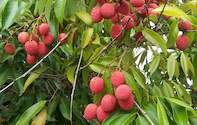Litchis are a tropical fruit that originated in China and has been farmed there for centuries. Although South Africa, during a good year, can be one of the top 10 litchi producers in the world with a production of 8 000 tonnes, it is still far behind China’s 200 000 tonnes, which was their 2018 production output.

Litchi Production Areas in South Africa
Litchis grow well in the hot, humid and frost-free areas of subtropical regions in South Africa, mainly the northeastern parts of South Africa.
Of South Africa’s litchi production, 60% come from the hot Lowveld area of Mpumalanga from towns such as Nelspruit, Hazyview and Malelane. Another 38% of South Africa’s litchis come from Limpopo - Tzaneen is a major litchi producing town - and the rest from other areas such as the KwaZulu-Natal Province.
The total area planted with litchis in South Africa was 1 124ha in 2016.
Litchi Seasons in South Africa
The Litchi season in South Africa begins around mid-October in the early areas of Malelane and Komatipoort in Mpumalanga, peaks in December and ends around the end of February with fruit picked in Nelspruit, Tzaneen and Louis Trichardt.
South Africa's Litchi Statistics
Taking production figures from the Department of Agriculture, Forestry and Fisheries (DAFF) report, the ‘South African Litchi Market Value Chain’ published in 2017 revealed that of the annual production of 8 411 tonnes, about 55% was exported and 32% processed. The balance of 13% was sold in the South African markets, much of it through informal traders. Of the exports, about 90% goes to the European Union, mainly to the Netherlands.
The value of the 2016 litchi exports was R760 million.
The 2018/2019 crop of about 4 800 tonnes, was markedly lower compared to the of 10 400 tonnes produced in 2017/2018. This is mostly due to unfavourable weather conditions during flowering, fruit set and fruit development in the early production regions of Mpumalanga.
Litchi Production Worldwide
About 96% of the world's litchi production is from the Northern Hemisphere with China, Taiwan, Vietnam, Thailand and India being the main producers. China is the main litchi producer in the world and contributes to about 70% of world production.
Africa, Australia and Madagascar are southern hemisphere producers. Australia has the longest litchi production season and can produce litchis from October to early April while Madagascar is the world’s largest supplier of litchis to Europe. Much of Malagasy litchi production is from wild-growing trees and virtually pesticide-free.
History of Litchi Farming
The litchi is native to the southern parts of China and northern Vietnam and has been grown there for centuries. It spread to India in the 1700s and probably spread to the West after its discovery in China by a Polish missionary. Litchi cultivation started in the West Indies in 1775 and was grown in greenhouses in Britain and France in the early 1800s.
Litchis were probably introduced in South Africa in the 1870s from Mauritius, where the currently-grown litchi cultivars come from. The first litchi tree was planted in the Botanical Gardens of Durban and spread from there to frost-free areas of Mpumalanga and Limpopo.
The South Africa Litchi Growers' Association (SALGA) was established in 1975. SALGA assists with litchi research, which supports growers with technical and market-related knowledge and develops new litchi markets.
By Marinda Louw
For bulk or export enquiries please use the enquiry link below.